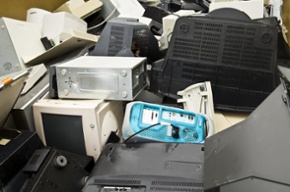 This post is contributed by Thomas Horner, Environmental Coordinator at Lifespan
This post is contributed by Thomas Horner, Environmental Coordinator at Lifespan
The answer to the question posed in the title of this article, “Is the e-waste problem getting worse?” is yes…and no. Yes, because in many parts of the world—including here in the United States—the adoption of responsible e-waste recycling practices is outpaced by the adoption among consumers and businesses of more and more electronics with shorter and shorter lifespans. The answer is also no, because governments and environmental organizations that recognize the rapidly accumulating piles of hazardous e-waste worldwide as a global crisis are taking steps to impose stricter regulations on the disposal of e-waste. Standards have been established to encourage businesses and individuals to choose responsible electronics recyclers for the disposal of their e-waste.
Why is e-waste a problem?
E-waste—electronic equipment like computers, televisions, and mobile devices that have reached the end of their lifecycle—poses a threat to the environment and human health and safety largely because of the toxins it contains. According to e-waste watchdog the Basel Action Network, creator of the e-Stewards standard for electronics recycling, the toxins contained in e-waste include mercury, lead, cadmium, arsenic, beryllium, and brominated flame retardants. Because many of these toxins can never completely be broken down, they can seep into the environment and the food and water supply if handled improperly, causing cancer, reproductive disorders, endocrine disruption, and other human health problems, BAN says.
Sadly, that is just what is happening for the bulk of e-waste worldwide. Here in the United States, experts estimate that only about 10 to 20 percent of electronics are recycled properly. The rest might end up in landfills or incinerators (releasing the toxic chemicals into the air). Many so-called recyclers—up to 80 percent, according to the Basel Action Network—export electronic equipment to less developed nations for processing because it is much more profitable than processing it domestically. “Once there, primitive technologies such as open air burning and riverside acid baths are used to extract a few materials,” says BAN on its e-Stewards website.
Why is the e-waste problem getting worse?
The relatively recent transition from mass use of CRT (cathode ray tubes) televisions and monitors to LCD displays is just one of the contributors to the escalation of the e-waste issues. Because CRTs are no longer in demand, there is a huge stockpile of leaded glass that can no longer be repurposed. Instead, expensive and difficult processes must be employed to remove lead from these glass screens and turn it into harmless substances like construction material. Because this process is expensive with little market for the end product, there is little incentive for more glass processing smelters to open. In fact, there are only four facilities in the entire United States that can properly process CRTs.
Globally, skyrocketing adoption of electronics in developing nations like India is another reason e-waste is expected to increase exponentially over the next several years. Some sources estimate that the e-waste output of countries like India will increase by a factor of up to 18 in the next decade. This rapid growth is not matched by the development of the electronic recycling industry in these nations. There is little incentive or infrastructure for this kind of industry to grow in developing nations. Though some large commercial smelting facilities and other electronics recycling programs exist, a large amount of electronic equipment in developing nations is simply broken down by hand and burned, melted, or dissolved by unskilled laborers.
On its e-Stewards website, “What’s driving the e-waste crisis?” the Basel Action Network lists eight additional reasons the e-waste problem is getting worse.
How is the e-waste problem improving?
While improper e-waste disposal remains a growing problem in the United States, lawmakers are beginning to recognize the severity of the situation and passing legislation to combat it. This July, Colorado became the 20th state in the U.S. to ban the disposal of electronics in a landfill.
Meanwhile, more and more businesses and individuals are beginning to rely on standards like e-Stewards to ensure their electronic waste isn’t contributing to the mounting crisis. For businesses, especially, which have compliance obligations and data security concerns as well as their own environmental and workplace safety policies, certification by e-Stewards, or the other industry certification, R2/RIOS, is increasingly a requirement for electronics recycling partners. By using certified recyclers, businesses and consumers help to reduce the problems of e-waste in environment.
Learn more about implementing proper e-waste disposal practices at your company
The global e-waste problem might be getting worse, but that doesn’t mean your company has to be part of it. Read about how to prevent your IT assets from reaching landfills in “The 2013 Guide to Environmental Compliance in IT Asset Disposition,” available for download by clicking below.


